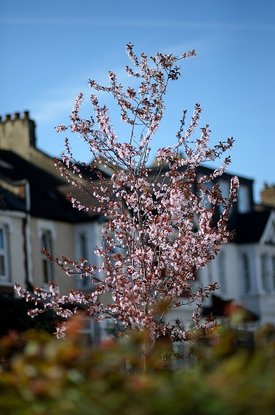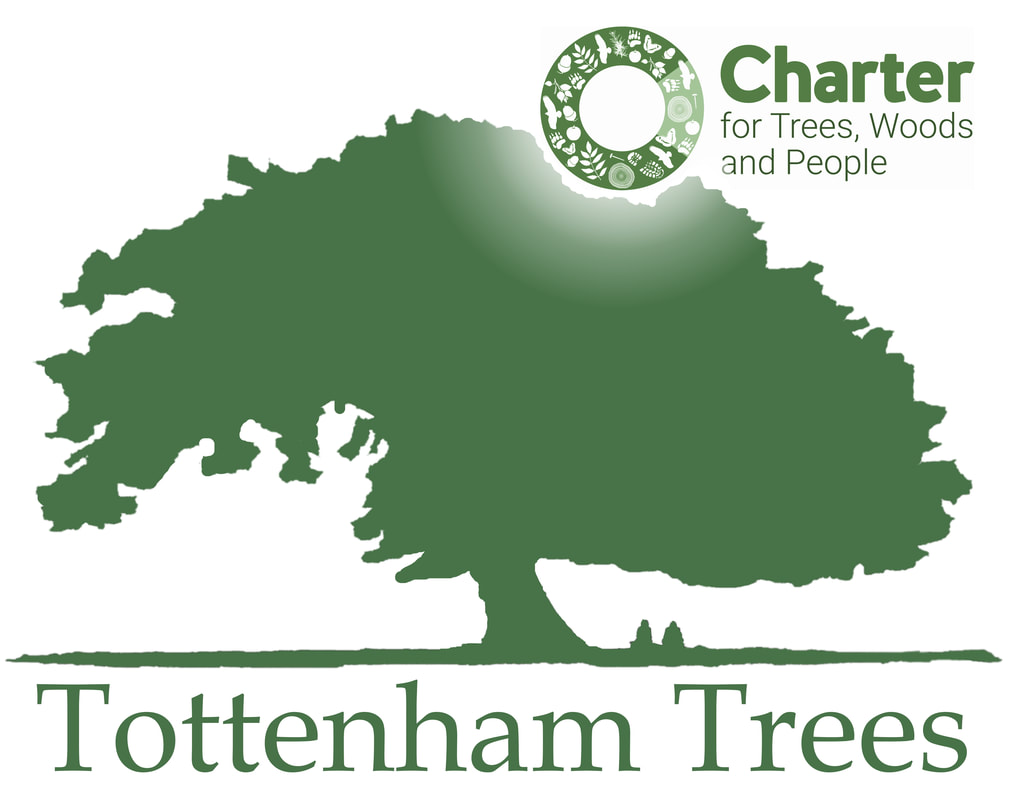|
Street trees in Haringey
|
Haringey Council:
Planting the ‘right tree in the right place’ is one of the objectives of the Haringey's Tree Strategy. The careful selection of appropriate tree species and planting location is essential to minimise future nuisance issues and unnecessary maintenance costs. The choice of tree species is dependent on suitability to the planting location. The selection of street trees is guided by their mature size, water demand, crown shape and future management requirements.Street trees are an integral and sometimes historical component of the urban landscape and as such are valued by local residents. Haringey has a street tree population in excess of 11,000 trees and is increasing the total year on year. Street trees are inspected regularly, with pruning works being carried out where necessary. London Plane and Limes trees are predominantly managed by pollarding on a three year cycle. The remaining ornamental street trees are maintained on a four yearly cycle. |
Haringey also has a Street Tree sponsoring scheme:
- Flowering Cherry (Prunus pandora) – small tree with ascending branches with pale pink blossom in March and early April
- Hawthorn (Crataegus monogyna 'Stricta') – small tree with a narrow columnar habit, good for tight spaces, white flowers in spring
- Ornamental Pear (Pyrus calleryana 'Chanticleer') – medium size tree with columnar habit, leaves turn orange and red in the autumn
- Rowan (Sorbus aucuparia 'Sheerwater seedling') - medium size tree with columnar habit, leaves turn orange and red in the autumn
- Serviceberry (Amelanchier arborea 'Robin Hill') – small tree with rounded crown, white flowers in spring and leaves turn red in the autumn
- Swedish whitebeam (Sorbus intermedia 'Brouwers') – medium size tree with ascending branches, white flowers in spring produces red berries in September
The programme of works in Haringey for summer and winter 2015-16, 2016-17 and 2017-18 can be found here
The tree which moves some to tears of joy is in the eyes of others only a green thing in the way
William Blake
Protecting Trees: Tree Preservation Orders
A Tree Preservation Order (TPO) is made by a local planning authority in England to protect specific trees, groups of trees or woodlands in the interests of amenity. Once an order is made cutting down, topping, lopping, uprooting or wilful damage or destruction of the tree is prohibited unless you have the written consent of the local planning authority. Cutting of roots is also a prohibited activity and requires the authority’s consent.
Owners of protected trees, as with owners of unprotected trees, are responsible for maintaining their trees, with no statutory rules setting out how often or to what standard. The local planning authority cannot require maintenance work to be done to a tree just because it is protected. However, the authority can encourage good tree management, particularly when determining applications for consent under a Tree Preservation Order. This will help to maintain and enhance the amenity provided by protected trees.
Arboricultural advice from competent contractors and consultants, or the authority, will help to inform tree owners of their responsibilities and options. It is important that trees are inspected regularly and necessary maintenance carried out to make sure they remain safe and healthy.
Local planning authorities can make a Tree Preservation Order if it appears to them to be ‘expedient in the interests of amenity to make provision for the preservation of trees or woodlands in their area.
‘Amenity’ is not defined in law, so authorities need to exercise judgment when deciding whether it is within their powers to make an Order.
Orders should be used to protect selected trees and woodlands if their removal would have a significant negative impact on the local environment and its enjoyment by the public. Before authorities make or confirm an Order they should be able to show that protection would bring a reasonable degree of public benefit in the present or future.
Trees with TPOs in Tottenham:
TPOs Tottenham N15
TPOs Tottenham N17
A Tree Preservation Order (TPO) is made by a local planning authority in England to protect specific trees, groups of trees or woodlands in the interests of amenity. Once an order is made cutting down, topping, lopping, uprooting or wilful damage or destruction of the tree is prohibited unless you have the written consent of the local planning authority. Cutting of roots is also a prohibited activity and requires the authority’s consent.
Owners of protected trees, as with owners of unprotected trees, are responsible for maintaining their trees, with no statutory rules setting out how often or to what standard. The local planning authority cannot require maintenance work to be done to a tree just because it is protected. However, the authority can encourage good tree management, particularly when determining applications for consent under a Tree Preservation Order. This will help to maintain and enhance the amenity provided by protected trees.
Arboricultural advice from competent contractors and consultants, or the authority, will help to inform tree owners of their responsibilities and options. It is important that trees are inspected regularly and necessary maintenance carried out to make sure they remain safe and healthy.
Local planning authorities can make a Tree Preservation Order if it appears to them to be ‘expedient in the interests of amenity to make provision for the preservation of trees or woodlands in their area.
‘Amenity’ is not defined in law, so authorities need to exercise judgment when deciding whether it is within their powers to make an Order.
Orders should be used to protect selected trees and woodlands if their removal would have a significant negative impact on the local environment and its enjoyment by the public. Before authorities make or confirm an Order they should be able to show that protection would bring a reasonable degree of public benefit in the present or future.
Trees with TPOs in Tottenham:
TPOs Tottenham N15
TPOs Tottenham N17




